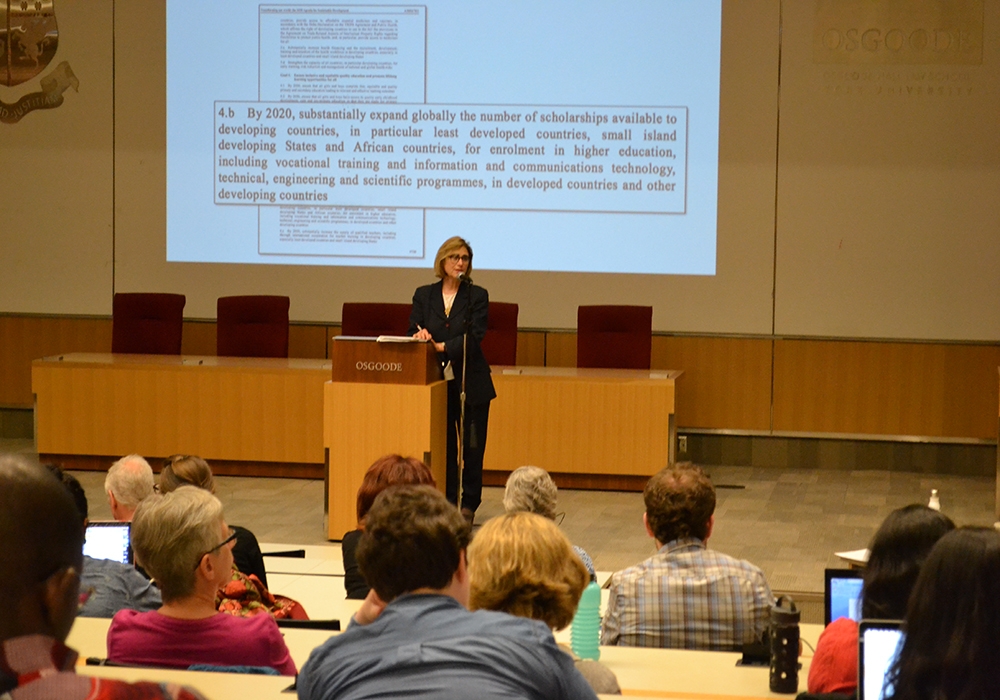Kanchi Uttamchandani | Assistant News Editor
Featured image by Hawa Sabriye
York’s Centre for Refugee Studies hosted renowned Harvard health and human rights professor Jacqueline Bhabha at this year’s Howard Adelman lecture about global migration and the plight of child refugees.
“In the context of the largest human displacement since World War II, Professor Bhabha’s ideas for a new paradigm to address distress migration are particularly timely,” says Christina Clark-Kazak, organizer of the event and associate dean at Glendon College.
“An unstoppable outpouring of refugees from the war-torn Middle East into Europe has provoked serious international scrutiny of established mechanisms and their limitations,” says Bhabha.
Bhabha highlights the harsh reality of child migration as an unprecedented aspect of contemporary migration issues.
In 2015, 26,000 unaccompanied refugee children arrived in Europe, while over a million children are languishing in underfunded refugee camps, according to Bhabha.
She explains that children and youth have access to limited legal avenues to mobility which is why child migration has become a pressing issue. One such avenue includes family reunification programs, which involve delays and economic or bureaucratic obstacles.
Another avenue is access to refugee resettlement and asylum, though there is limited understanding and acceptance of child persecution.
Bhabha presents a range of terms such as unaccompanied minors, separated children and children on the move to emphasize that child migrants hail from different backgrounds with distinct needs.
“Child migration, like adult migration, is mixed migration and is not susceptible to dichotomous classification of migrants into bona fide refugees covered by the 1951 convention on one hand, and economic migrants searching for a better life on the other,” she adds.
For instance, “children on the move” is indicative of a more inclusive terminology referring to all children who move between countries, voluntarily or involuntarily. It also covers cases where children move with or without parents.
Given the lack of legal options for child migrants, a new approach is deemed as necessary. Bhabha underlines two central elements of a reform-oriented discussion, namely the need for increased refugee resettlement and creation of new architecture for refugee protection that is more inclusive of mixed migration.
Risk factors impacting refugees, including demographic transitions, the impact of poverty, the growing gap within and between countries and gender-based discrimination must be considered when creating policy for refugees.
“Seventy-five per cent of world’s refugees come from only 11 countries,” says Bhabha. “Seven countries host more than 50 per cent of global refugees, showing the magnitude of intersecting societal and structural influence.”
Bhabha spoke extensively about initiatives aimed at the challenges associated with child migration, such as enforcing legal norms.
“Such preventative approaches to distress migration and addressing root causes of distress migration are usually found in the preamble, yet they don’t make it to the core of policy initiatives and budget lines,” she says.
Bhabha believes creating learning opportunities across borders would enhance education for all parties involved.
“Secondary and tertiary education is not considered a public social good when it should be. Hence, increasing child mobility is a win-win solution, not an act of charity,” she says.
“We need to think about education and skill training in a more bold, aggressive way such as crafting a range of educational opportunities to facilitate more flexibility by capitalizing on virtual technology,” she adds.
Bhabha says there is a need to move away from a border-driven control paradigm to a more strategic paradigm that adequately serves child migrants’ protection needs.


